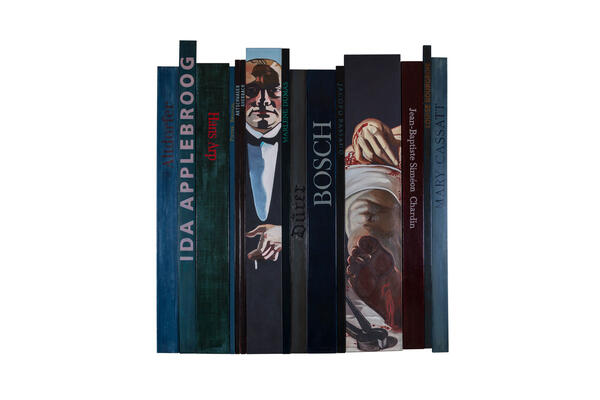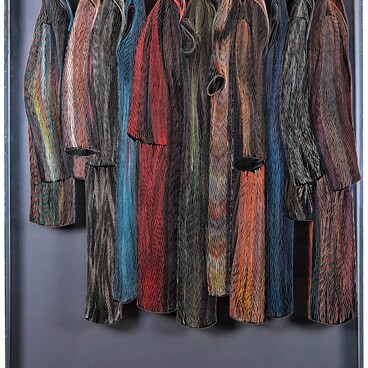“Artbooks” is a painting by the German artist Anne Berning. She used an asymmetrical canvas to depict the spines of 15 books about old and modern painters arranged in alphabetical order.
The main theme of Berning’s artworks is the history of painting and the attitude that modern painters express towards it. This painting shows the books with the names of old masters such as Albrecht Dürer, Hieronymus Bosch, Pieter Bruegel and Jean Baptiste Siméon Chardin standing next to the ones about less famous artists. The arrangement seems random and is reminiscent of that on the shelves in libraries and bookstores.
Anne Berning used two spines to depict the fragments of paintings from different eras. The left one shows a formally dressed man from the painting by the 20th-century German painter Max Beckmann, while the right one represents the painting by Annibale Carracci, the Italian painter of the 16th — 17th centuries. Such a contrast is used to demonstrate the idea of a bridge that exists to connect the art of the past and the present.
The questions that Berning pondered with her “Artbooks” address not only the history of art but also the future of art in the 21st century, the museums that will house modern works of art, and the new artists that will make their way to the metaphorical “bookshelf”.
The books are arranged in alphabetical order, just like in a library. Anne Berning left the row partly incomplete on purpose so that the viewers can imagine what they want there.
Anne Berning was born in 1958 in Werl, Germany. She studied art in Berlin and then interned in Vienna. In the 1990s, Berning received a few prestigious grants, including the Barkenhoff Grant, Alfred Krupp Grant, Bleckede Castle Art Center grant, as well as the funding from the cultural center of Salzau, and she used the money to organize art projects.
In her works, Berning turned to the subjects of artistic heritage and art history and also contemplated the attitude of modern artists regarding those issues. Her solo exhibitions were held in prominent museums and galleries across Germany, Italy, Canada, the USA and Spain. She now divides her time between two cities — Berlin and Wiesbaden — and works in collaboration with the Berlin gallery Kuckei+Kuckei.
The main theme of Berning’s artworks is the history of painting and the attitude that modern painters express towards it. This painting shows the books with the names of old masters such as Albrecht Dürer, Hieronymus Bosch, Pieter Bruegel and Jean Baptiste Siméon Chardin standing next to the ones about less famous artists. The arrangement seems random and is reminiscent of that on the shelves in libraries and bookstores.
Anne Berning used two spines to depict the fragments of paintings from different eras. The left one shows a formally dressed man from the painting by the 20th-century German painter Max Beckmann, while the right one represents the painting by Annibale Carracci, the Italian painter of the 16th — 17th centuries. Such a contrast is used to demonstrate the idea of a bridge that exists to connect the art of the past and the present.
The questions that Berning pondered with her “Artbooks” address not only the history of art but also the future of art in the 21st century, the museums that will house modern works of art, and the new artists that will make their way to the metaphorical “bookshelf”.
The books are arranged in alphabetical order, just like in a library. Anne Berning left the row partly incomplete on purpose so that the viewers can imagine what they want there.
Anne Berning was born in 1958 in Werl, Germany. She studied art in Berlin and then interned in Vienna. In the 1990s, Berning received a few prestigious grants, including the Barkenhoff Grant, Alfred Krupp Grant, Bleckede Castle Art Center grant, as well as the funding from the cultural center of Salzau, and she used the money to organize art projects.
In her works, Berning turned to the subjects of artistic heritage and art history and also contemplated the attitude of modern artists regarding those issues. Her solo exhibitions were held in prominent museums and galleries across Germany, Italy, Canada, the USA and Spain. She now divides her time between two cities — Berlin and Wiesbaden — and works in collaboration with the Berlin gallery Kuckei+Kuckei.



